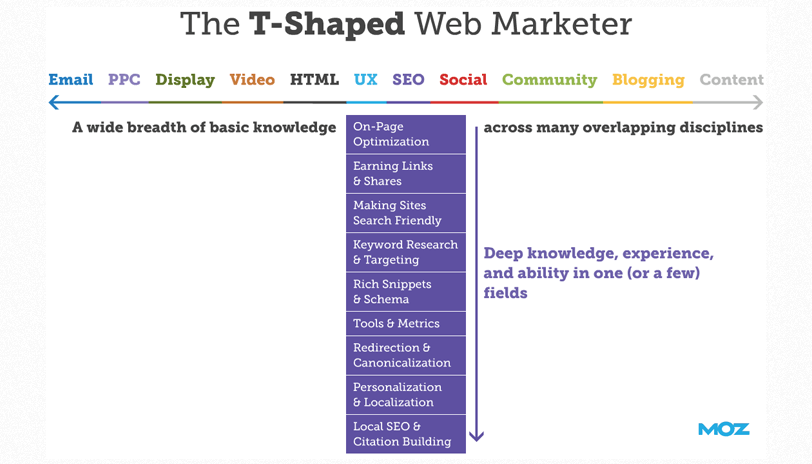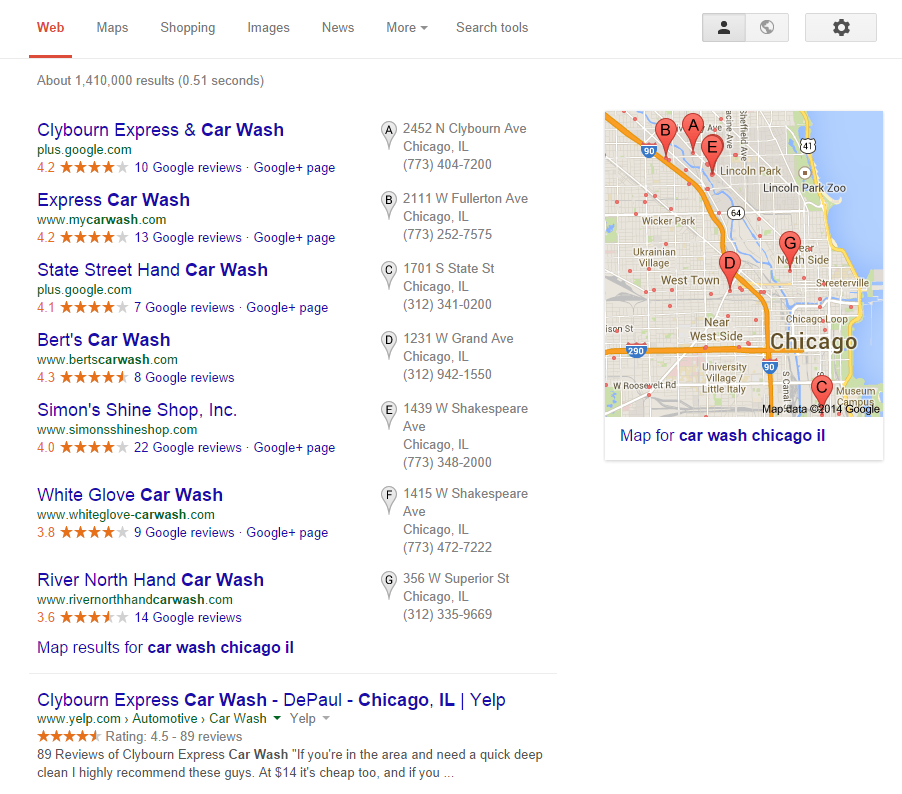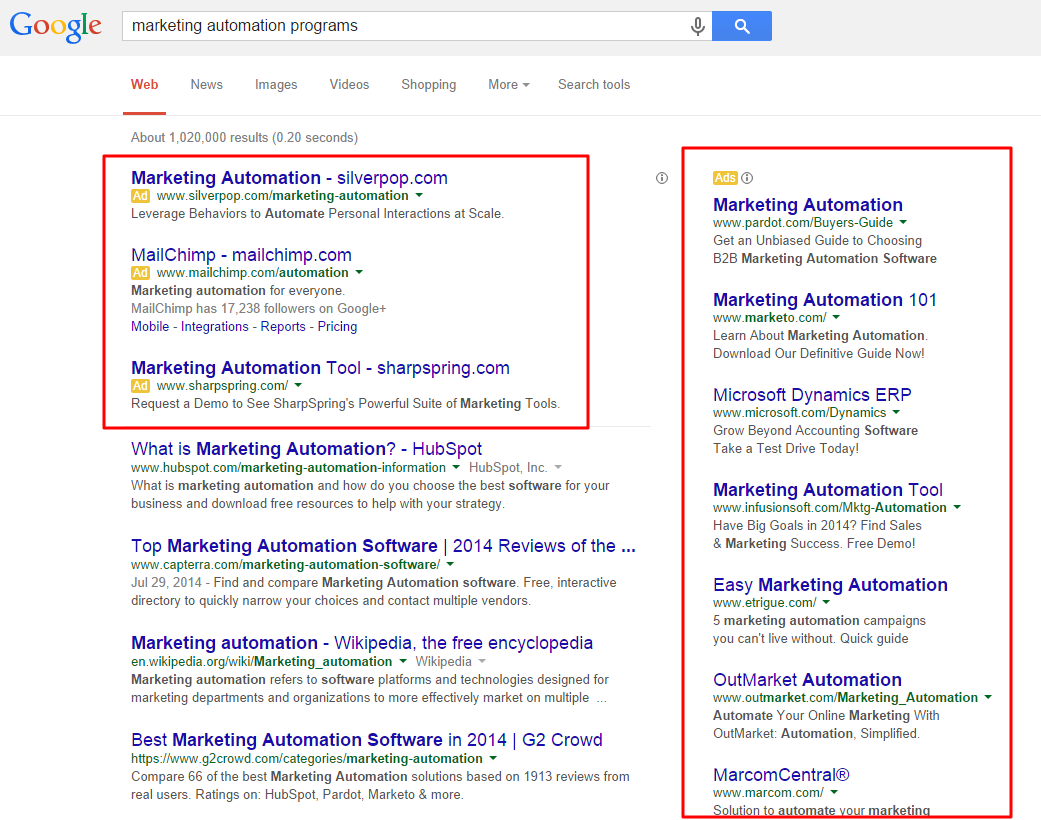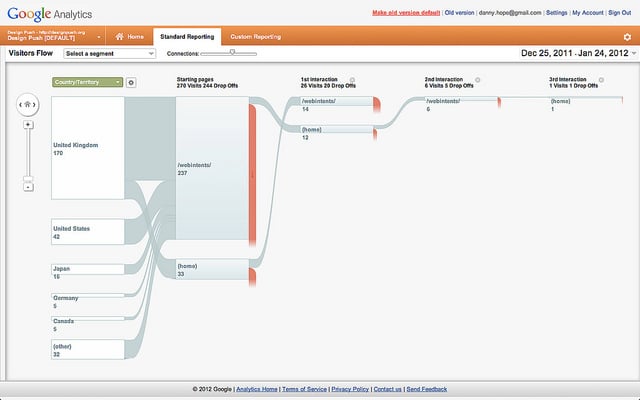 So you want to be an internet marketer? That’s great! According to WebDAM, marketing teams will spend more than $135 billion on new digital marketing collateral in 2014, and by 2015, internet advertising will make up nearly 25% of the total ad market. Whether you want to learn internet marketing to promote your website, to increase your chances of landing a modern marketing job or for any other reason, you’re in the right place!
So you want to be an internet marketer? That’s great! According to WebDAM, marketing teams will spend more than $135 billion on new digital marketing collateral in 2014, and by 2015, internet advertising will make up nearly 25% of the total ad market. Whether you want to learn internet marketing to promote your website, to increase your chances of landing a modern marketing job or for any other reason, you’re in the right place!
But while the materials and resources below will help you in your quest to learn internet marketing, one thing you must understand is that “online marketing” isn’t a single discipline. It’s actually a number of different tactics and techniques that support the common purpose of helping websites perform better online.
For this reason, it’s useful to keep the concept of the “T-shaped marketer” in mind. The term, coined by Rand Fishkin of Moz, refers to marketers that have a broad, surface-level understanding of every aspect of online marketing, and deep, in-depth knowledge of a single area they prefer.

To kickstart your online marketing education and become a T-shaped marketer, read through all of the different sections below and use the general introductions to determine which area interests you the most. Maintain a basic understanding of each of these topics, but use the “Recommended Resources” to dig deeper into the area you’ve chosen for your specialty.
Search Engine Optimization (SEO)
Search engine optimization (SEO) is the practice of enhancing a website’s code and content, as well as increasing the number of links pointing to it from other sites, for the purposes of improving its rankings in the organic search results and generating additional website traffic. Basically, the essential goal of an SEO worker is to have his website appear in the #1 position on a Google search results page whenever users search for specific keyword phrases.
How does he do this? Well, that’s where things get a little complicated. Search engine rankings are controlled by the algorithms that determine the results that are displayed in response to user queries – and it’s estimated that Google’s alone takes more than 200 different ranking factors into consideration. What’s worse, none of the search engines publish their exact ranking criteria to deter spammers from manipulating the results pages.
However, enterprising SEOs have, through trial and experimentation, uncovered many of these ranking signals, including:
- The presence of keyword phrases in key areas, including your site’s page title tags and heading tags.
- The presence of keyword phrases in the ALT tags on your site’s images.
- The length and quality of the content on your site’s individual pages and blog posts.
- The number and quality of external websites pointing at your pages.
- The number of social signals (including Facebook shares, Twitter retweets, Pinterest pins and more) your pages receive.
These ranking factors are applied slightly differently when it comes to universal keyword phrases (for example, “women’s blue shoes”) compared to search terms that demonstrate local search intent (as in, “BBQ restaurant Memphis TN”):
Universal SEO
Prior to April 2007, the Google search engine results pages (SERPs) consisted of ten links to ten web pages – nothing more, nothing less. Following the introduction of universal search at this point, the listings turned into mish-mashes of web page links, videos, maps, shopping items, news articles and more. As a result, modern SEOs must understand how to approach ranking in this environment, considering that publishing great on-site content is no longer the only way to score high listing positions.
Local SEO
Local SEO rules, on the other hand, apply to keyword phrases that relate to specific geographic locations. These search phrases (like, “car wash Chicago IL” or “NYC veterinarians”) often display listings for specific businesses – often in 3-pack or 7-pack formats – rather than individual web pages. These SERPs are controlled by a different set of algorithms than the universal SEO rules.

Most people who work in SEO specialize in particular SEO activities. For example, you might become an expert in auditing existing websites and providing recommendations on architecture changes that might improve the site’s odds of ranking well. Or, you might find work as a link builder, networking and doing outreach to help get links pointing to your site’s content on other website.
As a result, the skills that you need to be successful in SEO vary significantly, depending on the particular area that interests you. Those working on on-site audits must be analytical in nature, while those working on link building must be more outgoing. If you’re a strong writer, you might also be able to find work creating the on-site content that websites will use to improve their rankings for certain phrases.
Regardless of your specific skills or interests, any of the following resources should give you a great starting point for learning SEO:
Recommended Resources
- Quick Sprout University – SEO Training Videos
- Moz – The Beginners Guide to SEO
- Distilled – SEO 101
- Quick Sprout – The Advanced Guide to SEO
- Moz – The Moz Local SEO Learning Center
- Search Engine Watch
- Search Engine Land
- Search Engine Journal
Pay-Per-Click Marketing (PPC)
SEO is often referred to as a slow game, as making incremental changes to a site’s content and waiting for inbound links to pile up can take time. Want to see results faster? Learn pay-per-click marketing (sometimes referred to under the general heading of “search engine marketing”) and just pay for these visitors to arrive.
PPC marketing is somewhat self-explanatory. Instead of waiting for the search engines to send visitors to your website, you pay for them, using a number of different techniques:
Search Ads
Navigate to a results page on your favorite search engine, and you’re sure to see paid ads running alongside the organic results. These ads (usually denoted with the word “Ad” or marked by different colors or layouts) are referred to as “search ads” and are typically placed with the engines themselves.

Google Adwords is by far the largest search ads marketplace operating today. To run an ad through Google Adwords, you’ll create your ad text, select the search queries you’d like it to display for and set a bid based on what you’re willing to pay. Your cost-per-click (CPC) will vary based on the number of other advertisers competing for the same keyword phrase and the quality score your ad receives, among other factors.
Display Advertising
The search results aren’t the only places where paid ads appear. Advertisers can also elect to place “display advertising” orders (sometimes referred to as “content network ads”), by which their ads will appear in the ad blocks integrated into the content of other websites. These ads may be billed on a CPC basis, or may be priced based on the cost per one thousand views (CPM).

A variation on this advertising technique is retargeting, through which cookied visitors to your website are “followed” around the web by your ads as they visit other sites hosting display ad blocks. This tactic is quickly growing in popularity as advertiser competition and viewer burn out make traditional search ads less effective in driving website visits and sales.
Paid Social Advertisements
Yet another option for paid promotion exists on social networks like Facebook and Twitter. Facebook, in particular, has a robust advertising program that lets advertisers select from a number of different advertising formats and target their messages to such in-depth criteria as job title and stated interests. Facebook even has its own retargeting network – FBX – that lets savvy PPC marketers combine the benefits of Facebook targeting with the power of retargeting campaigns.
All that said, working in paid online advertising isn’t for everyone. The competitive nature of these channels makes it difficult to secure a positive return on investment (ROI), so an analytical nature is a must. But at the same time, PPC marketers must have the advertising insight to know which messages target visitors will respond best to. It’s a challenging field, for sure, but the ability to drive results quickly and implement tests that lead to measurable campaign improvements can be incredibly rewarding.
Recommended Resources
- Quick Sprout University – Paid Advertising Videos
- Hubspot Academy – Learn About Paid Search
- WordStream – PPC University
- Buffer – The Social Media Advertising Beginner’s Guide for Twitter, Facebook and LinkedIn
- PPC Hero
- PPC Blog
- Lynda.com – Google AdWords Essential Training ($25/mo)
Email Marketing
Professional digital marketers rarely specialize in email marketing alone, but it’s a powerful tactic that those in other specialties must be familiar with. That’s because some estimates claim that, for every $1 invested in email marketing, companies can experience an average return of as much as $44.25.
So what constitutes email marketing? Essentially, email marketing involves developing and deploying branded email messages with the intent to enhance a subscriber’s brand affinity, maintain top-of-mind awareness and drive online sales. If you’ve ever signed up to receive email messages from a favorite brand, you’ve likely seen everything from educational, informative missives to emails offering subscriber-only promotions or limited time offers that fall under this category.
Email marketing is another digital marketing technique that requires a cross-discipline skill set. To be good at email marketing, you must have:
- The ability to write persuasive message content and to create engaging imagery (or the connections to outsource these needs to those that have these skills)
- A knowledge of consumer psychology that will allow you to write email subject lines and message calls-to-action that get subscribers to take action
- The analytical skills to evaluate message open rates, create email split tests and analyze the data generated to help improve future messages
Think you’ve got what it takes to succeed with email marketing? Use the following resources to learn more about this fascinating tactic:
Recommended Resources
- Quick Sprout University – Email Marketing Videos
- Hubspot Academy – Email Marketing Training
- Copyblogger – Email Marketing: How to Push Send and Grow Your Business
- Marketo – The Definitive Guide to Engaging Email Marketing
- Pardot – The Complete Guide to B2B Email Marketing
- Pardot – Email Template Handbook
- MailChimp – Email Marketing Resources Library
Social Media Marketing

Sites like Facebook, Twitter, Google+ and Pinterest aren’t just fun places to hang out and waste time. They’re also important marketing channels for brands that want to connect with today’s consumers. And where these types of opportunities exist, there’s a need for marketers with the skills and knowledge needed to help companies take advantage of them.
In fact, these social media networks aren’t just important – they represent a fundamental shift in the way brands and consumers engage with each other. If you’re able to, think back to the days before the internet and suppose you had a bad experience with a company’s services. Before the rise of social networks, review sites and the internet in general, your opportunities for airing these grievances were pretty limited. Now, the opportunity to speak directly to the company and put your opinions in front of other potential customers is as simple as clicking onto Facebook and leaving a comment that everyone can see.
Smart companies respond by investing in these channels through a number of different activities:
- Posting engaging content to company profiles in order to attract a following and generate good will amongst followers.
- Actively responding to comments that are left on company profiles. Unfortunately, this may include following up on negative feedback left by unsatisfied customers in order to reach a positive conclusion.
- Reaching out to others with established followings in the industry in order to build brand awareness and increase follower counts.
- Creating contests, promotions and giveaways that increase engagement with the company’s profiles.
- Using paid social advertising strategies to improve reach (a task that’s even more important as social networks continue to decrease the organic reach of brand posts in an attempt to encourage more paid ads).
Being a good community manager requires an outgoing personality, as well as a sensitivity to the social norms of a given niche and the ability to respond sensitively to negative feedback. At the same time, those working in social media marketing must be able to interpret the data insight and analytics reported by each network in order to make future posts as engaging as possible for a company’s followers.
Ready to get started learning this technique? Head to these resources first:
Recommended Resources
- Quick Sprout University – Social Media Videos
- Moz – The Beginners Guide to Social Media
- Hubspot Academy – Learn About Social Media
- Social Media Examiner – Getting Started with Social Media
- Boot Camp Digital – Online Social Media Training ($497)
- Social Media Explorer
Content Marketing
These days, you can’t throw a stone online without hitting a post talking about how important content marketing is. And, to be fair, these posts aren’t wrong. According to Hubspot’s “2014 State of Inbound” report, inbound marketing delivers 54% more leads into the marketing funnel than traditional outbound marketing.
So what exactly is content marketing? The Content Marketing Institute defines it as:
“The marketing and business process for creating and distributing relevant and valuable content to attract, acquire, and engage a clearly defined and understood target audience – with the objective of driving profitable customer action.”
The best way to understand content marketing is, ironically, to look at what it isn’t. In the past, outbound marketing techniques dominate the advertising landscape. Brands ran TV commercials, published print ads in trade publications and sent direct mail pieces to qualified prospects – basically, pushing their messages out to people in the hopes of getting them to buy.
Content marketing, on the other hand, is sometimes called inbound marketing because it works in the opposite direction. Instead of sending messages out, content marketing involves creating high quality content pieces – such as blog posts, infographics, videos, white papers, ebooks and more – that can spread virally based on social recommendations. When people see a content piece they like, they share it with others, helping to spread the name of the company that published the materials in a non-threatening, non-salesy way.
But while the idea underpinning content marketing is relatively easy to grasp, its execution tends to be much more difficult. After all, most businesses are know that it’s important to publish high-quality content pieces. What is it that makes some companies successful, while others find themselves sitting on significant content resources that never gain viral traction?
To be successful, content marketing campaigns require a number of different conditions to be met:
- The content pieces generated must solve a problem that the audience cares about or provide some other value that viewers want. If the content piece isn’t immediately appealing, it won’t ever “go viral.”
- Any content materials created must clearly demonstrate value to viewers. Different factors contribute to this perception, but at a minimum, it’s important that the content piece is well produced and makes it immediately clear that a solution or other actionable piece of advice is included.
- The website or social profile where the content piece is hosted must make it easy to share. Viewers won’t go out of their way to share content – it’s up to you to simplify the process for them.
- Content materials must be promoted on the online communities where your target customers hang out. There are so many different websites online today sending out their own content pieces that success with content marketing isn’t as simple as publishing your pieces and waiting for your followers to get the ball rolling. You’ve got to be the one to jump start the initial promotion; otherwise, you risk being lost in the vast amounts of noise online.
Savvy readers will have noticed that these content marketing requirements create opportunities for marketers to get involved in inbound marketing in different ways. For example, you could work as a writer, designer, videographer or other creative professional that generates content marketing pieces for existing businesses. Or, if your skills lie more in networking, you could team up with companies or creative professionals to help get the content they create seen by a larger audience.
No matter how you want to be involved in content marketing (or even if you don’t ultimately want to make this technique your focus), it’s important to maintain a baseline familiarity with the subject. It’s clear that content marketing is becoming the standard paradigm in digital marketing, and there are no indications that this will change anytime soon. Prepare yourself by reviewing any of the following resources:
Recommended Resources
- Quick Sprout University – Content Marketing Videos
- Quick Sprout – The Advanced Guide to Content Marketing
- Copyblogger – Content Marketing eBook Series
- Pardot – Content Creation Guide
- Pardot – Guide to Inbound Marketing Best Practices
- Copyblogger – Authority Program ($399/yr)
- Content Marketing Institute Online Training ($995/yr)
Blogging
Truth be told, blogging isn’t really a category in its own right – it’s a single technique that falls under the much broader umbrella of content marketing. However, it deserves a little extra attention because, for most companies, it’s the cornerstone of the content campaign. Unlike higher-level content pieces like videos or infographics, nearly every company that takes up the mantle of content marketing will have a blog.
But again, things aren’t always as simple as they seem. Blogging – as you might expect by now – is about so much more than slapping a few quickly written paragraphs on a company website. Producing good blogs requires a variety of different skills:
- The ability to write in an engaging and conversational tone that engages readers.
- The ability to format and design content for internet viewers (here’s a hint – massive chunks of text just won’t cut it!).
- The ability to promote blog content so that it’s seen by a wider audience.
- The ability to post consistently – even on days when you really don’t feel like writing.
- The ability to use blog analytics to plan an editorial calendar and adjust course as needed.
No matter what type of digital marketing you want to get involved with, it’s a good idea to familiarize yourself – at least on a basic level – with the principles of solid blogging. Not only is this technique not going away anytime soon, it’s a relatively easy one to jump into as an online marketing worker, given the number of companies using this strategy.
Recommended Resources
- Quick Sprout – The Complete Guide to Building Your Blog Audience
- Hubspot Academy – Learn About Blogging
- ProBlogger
- Learn to Blog
- Lynda.com – Blogging for Your Business ($25/mo)
Conversion Rate Optimization
Love crunching numbers? Can’t get enough of big data? Then conversion rate optimization (CRO) might be for you!

CRO is one of those fields where the name is relatively self-explanatory. When you work in this field, your primary job is, well, to optimize a website’s conversion rate. Essentially, you look at the number of people that come to a website compared to the number of these visitors that go on to become customers and try to figure out what’s happening between these two milestones. Then, you test your hypotheses using tools like split tests, measure your data and recommend website improvements based on your findings.
Given this primary objective, those that are suited to work in CRO must be fanatical about data. At the same time, they must be willing to work like detectives, looking for clues to the problems that are affecting the sales funnel and proposing possible solutions based on their findings. Mix all that with a healthy interest in consumer psychology, and you’ve got the recipe for a great CRO worker.
Recommended Resources
- Quick Sprout University – Conversion Rate Optimization Videos
- Qualaroo – The Beginner’s Guide to Conversion Rate Optimization
- Quick Sprout – The Definitive Guide to Conversion Optimization
- Moz – The Definitive How-To Guide for Conversion Rate Optimization
- Unbounce – The Conversion Optimization Rulebook
User Experience
“User experience” (UX) represents the crossroads between design and data. More than just making things look pretty, UX designers work to cultivate on-site experiences that are intuitive for visitors and that help move viewers towards the completion of the business’s overall sales goals. It’s not the right specialty for everybody – as you need both design sense and specialized training – but those with the skills needed for good UX design will likely find themselves with plenty of work as the world shifts more and more online.
Recommended Resources
- UX Mastery – How To Get Started In UX Design
- The Hipper Element – UX Crash Course: 31 Fundamentals
- Lynda.com – User Experience Fundamentals for Web Design ($25/mo)
- Lynda.com – UX Design Techniques ($25/mo)
- UX Apprentice
- Communigator – 7 Stages of the Consumer Decision Making Process
Link Building
In the past, “good” SEO used to be as simple as manufacturing backlinks by pointing directory, article directory and forum profile links back to your site. Obviously, the advent of Google Panda and Google Penguin (among other algorithm updates) has changed that, which makes finding work exclusively as a link builder more challenging these days.
Even so, understanding how to build links in today’s SEO climate is an important skill to have, whether you choose to focus on this technique alone or use it to complement your work in other areas (SEOs, content marketers and social media marketers all benefit significantly from link building knowledge). If you enjoy the detective-like work of finding linking opportunities and possess the outgoing nature needed to secure them, spend some time with the following resources:
Recommended Resources
- Quick Sprout University – Link Building Videos
- Moz – The Beginner’s Guide to Link Building
- Quick Sprout – The Advanced Guide to Link Building
- Backlinko – Link Building: The Definitive Guide
- Point Blank SEO – Link Building Course ($67)
Web Analytics
There’s no doubt that we’re moving towards an era of big data. Today’s web marketer produces volumes upon volumes of digital data, but rarely has the time or understanding needed to parse this information into actionable KPIs. As with any other unmet need, this gap presents a great opportunity for those who choose to develop specialized knowledge in the measurement and evaluation of web analytics.
Web analytics workers may work embedded in traditional marketing departments, or they may freelance or perform consulting work for marketing agencies. Their primary tool of the trade is Google Analytics, though they pull data from a number of other sources, including heat-mapping tools, marketing automation programs, social profile management systems and more. Using their numbers-oriented, data-driven minds, they mine this information for trends that can be used to predict a business’s future results and identify changes that could lead to stronger performance.
Web analytics isn’t a field for everyone, but if you’ve got the mind for it, use the resources below as a starting point to your understanding of this technique:
Recommended Resources
- Hubspot Academy – Learn About Marketing Analytics & Testing
- Google – Analytics Academy
- Avinash Kaushik – Web Analytics Career Guide: From Zero To Hero in Five Steps
- Avinash Kaushik – Web Analytics: An Hour a Day ($45)
- Avinash Kaushik – Web Analytics 2.0: The Art of Online Accountability and Science of Customer Centricity ($25)
Growth Hacking
There’s one final technique that deserves recognition in any introductory internet marketing training guide – and that’s growth hacking. Coined by Sean Ellis in 2010, the term “growth hacking” encompasses a number of the different tactics described above in the pursuit of helping companies achieve above-average growth rates.
As an example, a growth hacker might start by evaluating a company’s web analytics, its existing user experience and its current onboarding process for weaknesses. While making adjustments designed to shore up these issues and implementing the marketing techniques described above, the growth hacker would carry out a CRO campaign designed to measure the impact of these changes. Depending on the evidence gathered, the growth hacker might implement a series of short development “sprints” retrospective designed to make the biggest impact in the shortest period of time possible.
Clearly, growth hacking requires a wide set of fully-developed skills – in fact, some thought leaders suggest that it’s impossible for one hacker alone to attain the expert-level proficiency needed in the various growth hacking disciplines to be effective. If the challenge in growth hacking appeals to you, and you think you’ve got what it takes to work across multiple fields in different capacities, start your research using the links below:
Recommended Resources
- GrowthHackers.com
- Growth Everywhere
- Quick Sprout – The Definitive Guide to Growth Hacking
- KISSMetrics – Learn Growth Hacking: 35 Resources to Help You Become a Growth Hacker
- Udemy – Growth Hacking: Lean Marketing for Startups ($49)
Maybe, as a result of these descriptions, you’ve identified a future career course that will have you specializing in a particular area of digital marketing. But even if you haven’t, the descriptions above and the recommended training resources provided have hopefully given you a basic understanding of the different marketing channels that exist online. Use this training guide as the foundation of your digital marketing knowledge and continue to add to it from time to time by reading articles, viewing presentations, attending webinars and more to keep your skills sharp.


